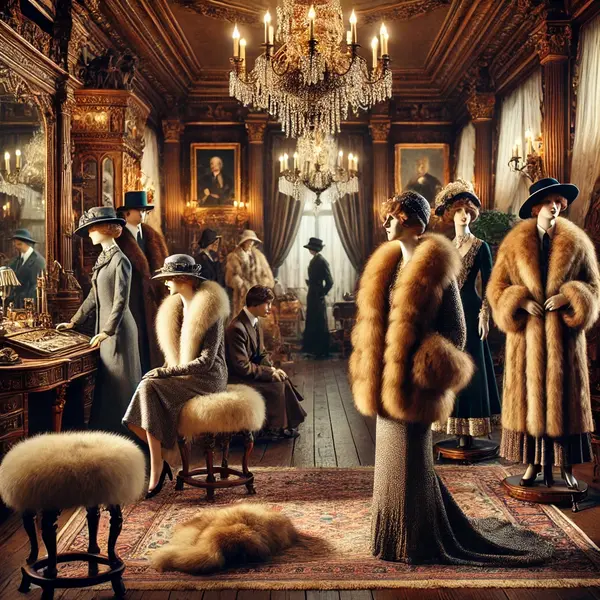Fur’s Trip in Fashion: From Luxury to Debate but its transformation into an image of high style is a fantastically contemporary development. Although fur has been utilized in garb for the reason that historic instances, it wasn’t till the 19th century that it became a defining detail of luxury and excessive style. This article explores the origins and evolution of fur in fashion, tracing its journey from a practical necessity to a coveted fame image.
Fur’s Historical Roots and Its Ascendancy in the 19th Century
The use of fur in clothing dates back to historical civilizations, wherein it served more often than not as a means of heat and safety. Over the centuries, fur has become a symbol of reputation, but it was at some point of the overdue 19th century that it clearly entered the world of excessive fashion. This length marked a great shift, pushed by way of technological improvements and changing social dynamics.
The Industrial Revolution performed a pivotal characteristic in this modification. As garment manufacturing has become greater green, fur garb has become an increasing number of on hand to the middle magnificence. No longer reserved for royalty and the elite, fur started to signify no longer simply warm temperature but sophistication and standing. European nobility and royalty, who had lengthy prized furs such as sable, mink, and chinchilla, now saw their style statements being emulated by the rising top middle elegance. Fur coats, stoles, and hats have become markers of social superiority, and the upward thrust of fashion magazines and distinguished designers like Charles Frederick Worth helped cement fur’s region in high style.
The Fur Trade and Its Impact on Fashion
The fur exchange of the 19th century was instrumental in popularizing fur inside European style circles. European settlers in North America engaged in widespread fur buying and selling, replacing items with Indigenous peoples for treasured furs. These furs had been then transported to Europe, wherein they have been used to create fashionable garments. The Hudson’s Bay Company, set up in 1670, emerged as a first-rate participant in this exchange, facilitating the glide of furs to satisfy the growing call for luxurious clothes.
As fur became extra available, it transitioned from being a specific Fur’s Journey in Fashion: From Luxury to Debate for the royal elite to an elegant object for the top class. The increased accessibility and affordability of fur further entrenched its repute as an image of wealth and refinement.
The Glamour of Fur in the 20th Century
The twentieth century noticed fur fashion attained new heights, particularly in the course of the Nineteen Twenties and Nineteen Thirties. Hollywood performed a massive role on this phenomenon, with stars like Greta Garbo, Joan Crawford, and Marilyn Monroe showcasing fur in their films and public appearances. This visibility within the glamorous global of cinema strengthened fur’s affiliation with sophistication and high society.
Technological advancements in fur processing for the duration of this period made garments lighter and greater comfortable, increasing their appeal. Fur has emerged as a fashionable fabric for celebrities and the elite, symbolizing every beauty and affluence.
The Ethical Debate and Decline of Fur Fashion
Fur’s Journey in Fashion: From Luxury to Debate its prominence, fur style faced increasing scrutiny towards the latter half of the 20 th century. Animal rights activists, together with organizations at the side of PETA and the Humane Society of America, highlighted the inhumane elements of fur farming and production. Their campaigns, which protected picture classified ads and protests, played an essential function in transferring public opinion.
In response to these ethical issues, many designers and stores commenced phasing out actual fur in preference to faux options. The decline of fur in mainstream fashion displays broader societal shifts inside the course of extra humane and ethical practices in the style company.
The Current State of Fur in Fashion
Today, fur stays a controversial topic inside the fashion enterprise. While many luxury manufacturers have pledged to do away with fur from their collections—consisting of Gucci, Prada, Chanel, and Versace—fur continues to maintain importance in positive regions and cultures. In locations like Russia and China, fur remains a symbol of prestige and culture, and the fur exchange continues to be active.
This dichotomy highlights the continuing debate surrounding fur in style: while a few view it as an crucial element of class, others consider it outdated and unethical. The evolution of fur in style underscores its complex dating with societal values and trends.
Conclusion
The story of fur in fashion is certainly one of transformation and controversy. From its early use as a sensible material to its rise as a symbol of luxury and status, and its subsequent moral scrutiny, fur has left an indelible mark on the fashion world. As the industry continues to evolve, fur remains a poignant reminder of the interplay between subculture, innovation, and social duty.



